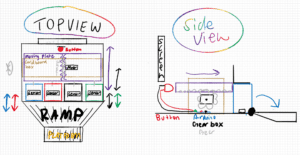Sort your Trash; Save the World
Sort Your Trash; Save the World is a project with an intended purpose to help people better understand how to sort their trash. While many people do not see the effects in the short-term, the long-term effects of their carelessness will more than likely end in the destruction of the Earth and, consequently, the human race (not to be dramatic). In collaboration with Salome, we aim to create a project with an educational purpose of having a fun and interactive way for people (I say people broadly to mean people of ALL ages) to learn how to sort their trash.

Above, I have posted my design idea. The interface will appear as that of an arcade-style game. There will be a screen behind the game that will act as a display. Here, cards will pop up with an image and the name of the item. Next to the cards will be a globe that will appear as a bomb with a fuse slowly getting shorter and shorter. The aim of the game is to sort x number of cards before the Earth explodes. The beginning of the game will start with the user selecting, 10, 20, 30, or 40 cards to sort in 30 seconds. You will be able to choose the number based on which can lid you close. Each bin (there are 4) will have a light sensor at the bottom. When you close the lid, the sensor will sense “darkness” and this range will be used to select. There will be a countdown and the game will begin. An image will appear and then you must close the lid or open the lid depending on if that is the appropriate bin. Your score count will increase as you get more and more correct. You will have three strikes. The first time you try to sort one item incorrectly, then a BIG red “X” will appear on the screen and you have to try again. Once you get 3 red “X”s then the bins will fall forward and you will have lost the game. If you are able to get the number sorted in time, then the same level used to slam the bins forward, will push the button to defuse the bomb.
If we have adequate time and are able to complete the project this far, I would like to implement a “progress” page that will show the cards you sorted incorrectly and tell you which bin to place them in.
Here is the master schedule for our plan of attack:
| Sunday | Monday | Tuesday | Wednesday | Thrursday | Friday | Saturday |
| 21
final proposal |
22 | 23
|
||||
| 24
design playing field: bins/ box/ gear |
25
print/create game field |
26
design “ticking time bomb globe” |
27
print/create game field |
28
steph away card design |
29
steph away card design |
30
steph away card design |
| 1
draft circuit |
2
assemble: sensors/ bins |
3
assemble: sensors/ bins |
4
code: sensors/ bins |
5
assemble: gears / button |
6
code: interface for game on screen |
7
have project finished |
| 8 | 9 | 10
project due |
11 | 12
blog post |
13 | 14 |
Basically, the first week will be designing the physical aspect of our project as well as the images that will be displayed. If they are simple, then we can figure out how to create them ourselves as doodles in Processing, or we can import images into a library. The second week will be coding and assembly week. We will make our circuits as well as coding the interface for our device.
From the projects that I have researched (such as the Interactive Walls), interactive design projects tend to be the most successful when people are smiling. In Daniel Shiffman’s book, Learning Processing – while the majority of the book is written about coding certain examples for processing – one of the chapters entitled, “The World Revolves Around You,” emphasizes the reason for doing your projects. For me, if your device can make someone smile, then I think you have accomplished your task. We will accomplish this through stylish interface as well as an aesthetically pleasing physical design that the users enjoy touching and manipulating. I think something we need to be careful of is that often times with projects like these, they are not built very strong; this means that you as the designer are worried every time someone touches your project that a wire will become loose or something falls off. I want to build this project in confidence of my design and of 100% accuracy. While trashing sorting is currently an on-going affair in China, it should be a more commonly done practice around the world. The overall goal of having this device is to show people how easy it is to sort your trash if you just take a few seconds to do it correctly.
Sources:
Shiffman, Daniel. Learning Processing : A Beginner’s Guide to Programming Images, Animation, and Interaction, Elsevier Science & Technology, 2015. ProQuest Ebook Central, https://ebookcentral-proquest-com.proxy.library.nyu.edu/lib/nyulibrary-ebooks/detail.action?docID=4003651.